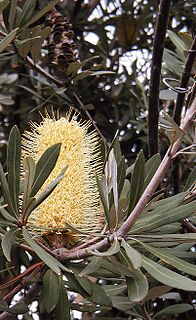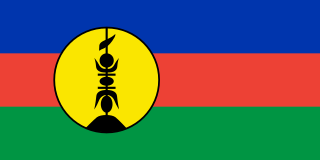
Hakea is a genus of about 150 species of plants in the Family Proteaceae and are endemic to Australia. They are shrubs or small trees with leaves that are sometimes flat, otherwise circular in cross section in which case they are sometimes divided. The flowers are usually arranged in groups in leaf axils and resemble those of other genera, especially Grevillea. Hakeas have woody fruit which distinguishes them from grevilleas which have non-woody fruit which release the seeds as they mature. Hakeas are found in every state of Australia with the highest species diversity being found in the south west of Western Australia.

Banksia subg. Banksia is a valid botanic name for a subgenus of Banksia. As an autonym, it necessarily contains the type species of Banksia, B. serrata. Within this constraint, however, there have been various circumscriptions.

Banksia conferta, the glasshouse banksia,) is a species of montane shrub or small tree in the plant genus Banksia. It occurs as distinct subspecies in two widely separated locations: B. conferta subsp. conferta in southern Queensland on the Lamington Plateau and further north in the Glass House Mountains; and B. conferta subsp. penicillata in New South Wales from Bowral to north of Lithgow.

Banksia ser. Salicinae is a valid botanic name for a series of Banksia. First published by Carl Meissner in 1856, the name has had three circumscriptions.

The genus Banksia L.f. (Proteaceae) is a 1981 monograph by Alex George on the taxonomy of the plant genus Banksia. Published by the Western Australian Herbarium as Nuytsia3(3), it presented George's taxonomic arrangement of Banksia, the first major taxonomic revision of the genus since George Bentham published his arrangement in Flora Australiensis in 1870.
This is a timeline of developments in knowledge and understanding of the Australian plant genus Banksia:

The Newnes Plateau banksia is a plant only described in 1981 though collected in the 1970s. It was first described on the Newnes Plateau in the southernmost part of the Wollemi National Park, though more recent collections have widened its distribution, with the northernmost occurrence upon Mt Monundilla.
Banksia densa is a shrub endemic to Western Australia. It was known as Dryandra conferta until 2007, when all Dryandra species were transferred to Banksia by Austin Mast and Kevin Thiele. As there was already a plant named Banksia conferta, Mast and Thiele were forced to choose a new specific epithet; their choice, "densa", is from the Latin densus, in reference to the way the leaves are densely crowded around the inflorescences.
Kevin Thiele and Pauline Ladiges taxonomic arrangement of Banksia, published in 1996, was a novel taxonomic arrangement that was intended to align the taxonomy of Banksia more closely with the phylogeny that they had inferred from their cladistic analysis of the genus. It replaced Alex George's 1981 arrangement, but most aspects were not accepted by George, and it was soon replaced by a 1999 revision of George's arrangement. However some herbaria have continued to follow Thiele and Ladiges on some points.

Alex George's taxonomic arrangement of Banksia was the first modern-day arrangement for that genus. First published in 1981 in the classic monograph The genus Banksia L.f. (Proteaceae), it superseded the arrangement of George Bentham, which had stood for over a hundred years. It was overturned in 1996 by Kevin Thiele and Pauline Ladiges, but restored by George in 1999. A recent publication by Austin Mast and Kevin Thiele suggests that it will soon be overturned again.

Alex George's taxonomic arrangement of Dryandra was the first modern-day arrangement of that taxon. First published in Nuytsia in 1996, it superseded the arrangement of George Bentham, which had stood for over a hundred years; it would later form the basis for George's 1999 treatment of Dryandra for the Flora of Australia. In accordance with contemporary thinking, George treated Dryandra as a genus, dividing it into three subgenera, the largest of which was divided into 24 series. The arrangement stood until 2007, when Dryandra was transferred into Banksia as B. ser. Dryandra. No alternative has yet been proposed.

Dryandra subg. Dryandra is an obsolete clade of plant. It was a series within the former genus Dryandra. The name was first published at sectional rank as Dryandra verae in 1830, before being renamed Eudryandra in 1847, the replaced by the autonym at subgenus rank in 1996. It was ultimately discarded in 2007 when Austin Mast and Kevin Thiele sunk Dryandra into Banksia.

Banksia conferta subsp. conferta is a subspecies of Banksia conferta. As an autonym, it is defined as encompassing the type material of the species. It grows only in Queensland between the Lamington Plateau and the Glass House Mountains.
Banksia densa var. parva is a variety of Banksia densa. It was known as Dryandra conferta var. parva until 2007, when Austin Mast and Kevin Thiele sunk all Dryandra into Banksia. Since there was already a Banksia named Banksia conferta, Mast and Thiele had to choose a new specific epithet for D. conferta and hence for this variety of it. As with other members of Banksia ser. Dryandra, it is endemic to the South West Botanical Province of Western Australia.
Banksia densa var. densa is a variety of Banksia densa. It was known as Dryandra conferta var. conferta until 2007, when Austin Mast and Kevin Thiele sunk all Dryandra into Banksia. Since the name Banksia conferta had already been used, Mast and Thiele had to choose a new specific epithet for D. conferta and hence for this variety of it. As with other members of Banksia ser. Dryandra, it is endemic to the South West Botanical Province of Western Australia. As an autonym, it is defined as encompassing the type material of the species.













